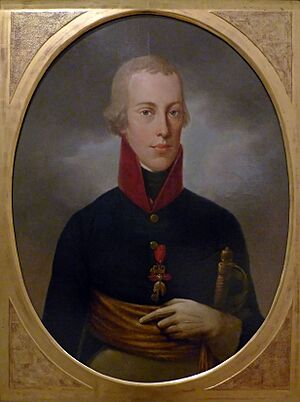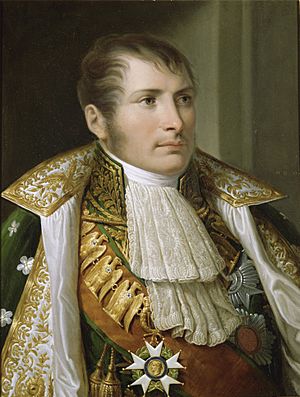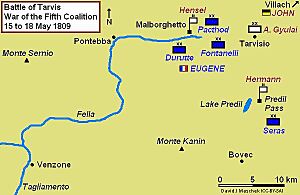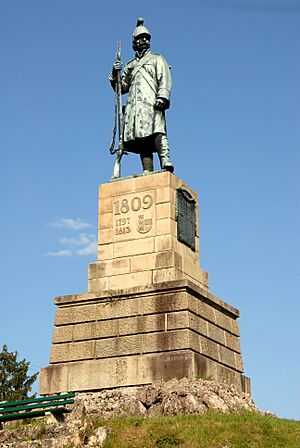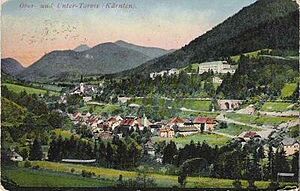Battle of Tarvis (1809) facts for kids
Quick facts for kids Battle of Tarvis (1809) |
|||||||
|---|---|---|---|---|---|---|---|
| Part of the War of the Fifth Coalition | |||||||
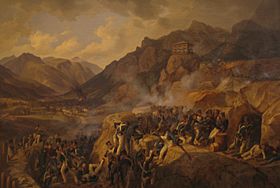 Storming of Malborghetto Fort by Albrecht Adam (1786–1862) |
|||||||
|
|||||||
| Belligerents | |||||||
| Commanders and leaders | |||||||
| Strength | |||||||
| Tarvis: 25,000 Predil: 8,500, 12 guns Malborghetto: 15,000 Total: 38,500 men |
Tarvis: 6,000, 10 guns Predil: 250, 8 guns Malborghetto: 650, 10 guns Total: 6,900 men, 28 guns |
||||||
| Casualties and losses | |||||||
| Tarvis: 380 Predil: 450 Malborghetto: over 80 Total: Over 1,010 men |
Tarvis: 1,789, 6 guns Predil: 250, 8 guns Malborghetto: 650, 10 guns Total: 2,689 men, 24 guns |
||||||
The Battle of Tarvis was a series of fights that took place from May 15 to May 18, 1809. It involved the French and Italian armies led by Eugène de Beauharnais and Austrian forces under Albert Gyulai. The main battle happened near Tarvisio, which was then an Austrian town called Tarvis.
During these battles, Eugène's army defeated Gyulai's troops. At the same time, small groups of Austrian soldiers bravely defended two forts nearby: the Malborghetto Blockhouse and the Predil Blockhouse. Even though they fought hard, they were eventually overcome by the much larger French and Italian forces.
Capturing these important mountain passes allowed the French and Italian armies to move into the Austrian region of Kärnten. This was part of a bigger conflict called the War of the Fifth Coalition. Tarvisio is located in the far northeast of modern-day Italy, close to the borders of both Austria and Slovenia.
Eugène's main army marched along the Fella River valley. On May 15, they were stopped by the Malborghetto fort. After a strong attack, Eugène's soldiers captured the fort on the morning of May 17. Later that day, the French and Italians defeated Gyulai's division near Tarvisio, causing many losses for the Austrians.
Another French and Italian group tried to join Eugène from the south. They were stopped on May 15 by the Predil fort. On May 18, Predil was also captured, and its defenders fought until the very end. Today, monuments at both forts honor the brave Austrian soldiers who died there.
Contents
What Led to the Battle?
Early Fights in Italy
At the start of the War of the Fifth Coalition, Austria planned for its army, led by Archduke John of Austria, to invade and take over the Venetia region in northeast Italy. Archduke John's army was not very big for such a large task.
He had about 40,000 soldiers ready for the invasion. His main commanders were Albert Gyulai and his brother Ignaz Gyulai.
On the other side, Eugène de Beauharnais commanded about 70,000 French and Italian troops in his Army of Italy. Many of his soldiers were spread out across the Kingdom of Italy.
On April 16, 1809, Eugène attacked with only about 37,000 soldiers. At the Battle of Sacile, Archduke John's army badly defeated Eugène's forces. Eugène's army lost 6,500 men, while the Austrians lost 3,600.
The defeated French and Italian army retreated to Verona, where they gathered more soldiers until they had 60,000 men. Meanwhile, Archduke John sent some of his troops to surround fortresses and watch the French army in Venice. By April 28, the Austrian army arrived near Verona with only 30,000 troops.
After hearing that the main Austrian army had been defeated at the Battle of Eckmühl on April 22, Emperor Francis I of Austria ordered Archduke John to retreat back to Austria.
The Retreat and Chase
After some fighting near Soave at the end of April, Archduke John began his retreat on May 2. His rear guard, led by Johann Maria Philipp Frimont, did a good job protecting the retreating army.
On May 8, John tried to defend a strong position behind the Piave River. But in the Battle of Piave River, Eugène defeated him again. The Austrians lost 5,000 men, while the French and Italians lost about 2,000.
On May 11, the French and Italian advance guard attacked Frimont's 4,000-man rear guard at San Daniele del Friuli. The Austrians were badly beaten, losing about 2,000 men. French losses were much smaller. After another small fight at Venzone, Frimont retreated north along the Fella River valley, burning bridges as he went to slow down the French.
Getting Ready for Battle
Archduke John took about 19,000 soldiers back to Tarvis. He sent Ignaz Gyulai and 5,000 soldiers to Carniola (modern-day Slovenia). John also called back another commander, Chasteler, from Tyrol, hoping to gather enough troops to fight Eugène again.
Eugène planned to break through the Carnic Alps by attacking from several directions. He sent one group under Jacques MacDonald to capture Ljubljana in Slovenia. From there, MacDonald could either meet up with another French general, Auguste Marmont, or capture other Austrian cities.
Eugène sent another division under Jean Mathieu Seras north towards Tarvis through the Predil Pass. The main part of his army, about 25,000 strong, marched north from Osoppo along the Fella valley, heading for Tarvis and Villach. This large force included troops led by Paul Grenier and Louis Baraguey d'Hilliers.
As the Austrians retreated, they destroyed roads and bridges to slow down the French. Eugène had to send his heavy equipment, like artillery and wagons, on a different, longer path. He continued to advance with his infantry and lighter guns towards Pontebba (Pontafel).
The Battle Unfolds
The Attack on the Forts and Tarvis
The Fella River valley turns east at Pontebba, leading to Malborghetto, and then another 10 kilometers to Tarvisio. To reach Tarvisio from the Soča (Isonzo) valley, there's a road from Bovec that goes north and then west over the Predil Pass. The Predil blockhouse (a small fort) is near this pass. The Malborghetto blockhouse is on a mountain spur overlooking the Fella valley.
In mid-May, Archduke John organized his army. Albert Gyulai was at Tarvis with about 8,340 soldiers. Other Austrian forces were spread out in different areas.
Historians have slightly different numbers for the Austrian forces. One account says Albert Gyulai had about 6,000 troops near Tarvis, with 650 soldiers and 10 guns at Malborghetto, and 250 soldiers and 8 guns at Predil. Another historian suggests slightly different numbers: 3,500 Austrians at Tarvis, 450 at Malborghetto, and 250 at Predil.
Eugène's army was divided. General Grenier's troops and General Baraguey d'Hilliers' troops were part of the main force. An advance group, led by General Joseph Marie, Count Dessaix, reached the Malborghetto fort on May 15.
Eugène ordered Grenier to capture the fort, while Baraguey d'Hilliers kept Gyulai from interfering from Tarvis. Dessaix and other divisions moved through mountain trails to attack the Malborghetto fort from the east. On May 16, Baraguey d'Hilliers fought with Gyulai, who then left Tarvis and took up a defensive position east of the town.
At 9:30 AM on May 17, about 15,000 French and Italian soldiers attacked the Malborghetto fort from two sides. The fort fell in just 30 minutes. Around 300 Austrians were killed and 350 captured. The French and Italians reported only 80 casualties. They also captured supplies and 13 cannons. The fort's commander, Engineer Captain Friedrich Hensel, died leading his small garrison of about 24 artillerymen and two companies of soldiers.
After capturing Malborghetto, Grenier's victorious soldiers quickly marched east to Tarvis to help attack Gyulai. The Austrian commander had taken a position behind the Slizza (Gailitz) stream with 11 battalions and four cavalry units. They had some defenses, but only 10 of the planned 24 cannons were in place.
Around midday, Eugène ordered his troops forward. While Grenier's corps fought Gyulai's center, an Italian division attacked the Austrian left side. The Italians captured a key defensive position and began to break through Gyulai's lines from the south. As the Austrian defense collapsed, Grenier's troops attacked from the front.
Gyulai's troops fled in a complete defeat, losing 3,000 men (killed, wounded, and captured) and most of their cannons. The Austrians officially reported losing 1,789 men and six guns out of 3,500 soldiers. Eugène reported 80 killed and 300 wounded for his side.
Meanwhile, the group under Seras faced resistance on May 15 when they reached the Predil Pass blockhouse. While Eugène was defeating Gyulai on May 17, Seras tried to bombard the Predil fort, but it had no effect. Engineer Captain Johann Hermann von Hermannsdorf commanded the fort's small garrison of 250 Croatian soldiers.
Eugène needed to use Predil Pass for his artillery, cavalry, and wagons to reach Tarvis. He sent three battalions to attack Hermann's fort from one side, while Seras attacked from the other. The French assault began on May 18 and met with very strong resistance.
Captain Hermann and every single one of the 250 Croatian defenders were killed in their last stand. The French and Italian forces lost about 450 men (killed and wounded) out of 8,500 infantry and 12 guns.
What Happened Next?
The Austrian plan to invade Italy turned out to be a mistake. The losses during the invasion and retreat greatly weakened Archduke John's army. Instead of having enough soldiers to defend the mountain passes, John was left with too few.
Capturing Tarvis and its forts gave Eugène an open path to Villach, which he took on May 20. His troops then captured Klagenfurt the next day. In both cities, the French and Italians found useful supplies.
Eugène had to pause for a few days to let his artillery, cavalry, and wagons catch up with his infantry. John retreated to Graz, arriving on May 24, followed by Gyulai's tired division. Eugène's scouts soon found another Austrian division marching nearby, and he sent Grenier's corps to stop them. The next battle was the Battle of Sankt Michael on May 25.
Monuments honoring Engineer officers Hensel and Hermann, and the Austrian soldiers who died, are located at both the Malborghetto and Predil forts. The monument at Predil was built in 1849.
Images for kids


